Critical Analysis: Lean & TQM for Change in Manufacturing/Service
VerifiedAdded on 2023/03/31
|11
|2065
|320
Essay
AI Summary
This essay critically evaluates the usefulness of Lean Production and Total Quality Management (TQM) as change tools for both manufacturing and service companies, specifically focusing on Toyota and McDonald's. Lean production is examined as a method to minimize waste in manufacturing without sacrificing productivity, while TQM is presented as a tool for continual process improvement and error elimination. The essay discusses the implementation, advantages, and disadvantages of these tools in each organizational context, highlighting their impact on efficiency, quality, and customer satisfaction. The analysis concludes that while both tools can be effective, their success depends on careful implementation and consideration of the specific challenges and opportunities within each industry.

Organisational Development and Change
Paraphrase This Document
Need a fresh take? Get an instant paraphrase of this document with our AI Paraphraser
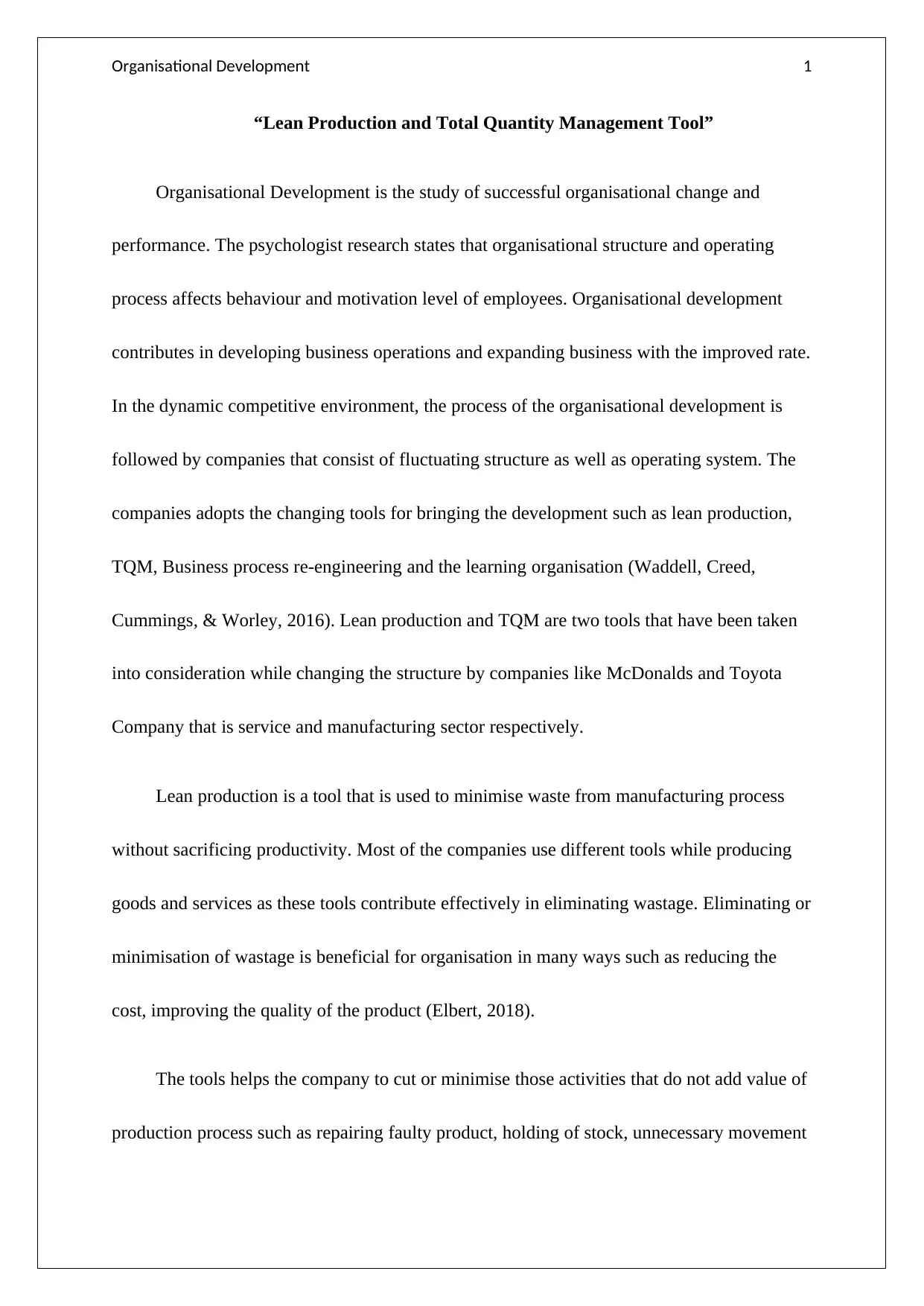
Organisational Development 1
“Lean Production and Total Quantity Management Tool”
Organisational Development is the study of successful organisational change and
performance. The psychologist research states that organisational structure and operating
process affects behaviour and motivation level of employees. Organisational development
contributes in developing business operations and expanding business with the improved rate.
In the dynamic competitive environment, the process of the organisational development is
followed by companies that consist of fluctuating structure as well as operating system. The
companies adopts the changing tools for bringing the development such as lean production,
TQM, Business process re-engineering and the learning organisation (Waddell, Creed,
Cummings, & Worley, 2016). Lean production and TQM are two tools that have been taken
into consideration while changing the structure by companies like McDonalds and Toyota
Company that is service and manufacturing sector respectively.
Lean production is a tool that is used to minimise waste from manufacturing process
without sacrificing productivity. Most of the companies use different tools while producing
goods and services as these tools contribute effectively in eliminating wastage. Eliminating or
minimisation of wastage is beneficial for organisation in many ways such as reducing the
cost, improving the quality of the product (Elbert, 2018).
The tools helps the company to cut or minimise those activities that do not add value of
production process such as repairing faulty product, holding of stock, unnecessary movement
“Lean Production and Total Quantity Management Tool”
Organisational Development is the study of successful organisational change and
performance. The psychologist research states that organisational structure and operating
process affects behaviour and motivation level of employees. Organisational development
contributes in developing business operations and expanding business with the improved rate.
In the dynamic competitive environment, the process of the organisational development is
followed by companies that consist of fluctuating structure as well as operating system. The
companies adopts the changing tools for bringing the development such as lean production,
TQM, Business process re-engineering and the learning organisation (Waddell, Creed,
Cummings, & Worley, 2016). Lean production and TQM are two tools that have been taken
into consideration while changing the structure by companies like McDonalds and Toyota
Company that is service and manufacturing sector respectively.
Lean production is a tool that is used to minimise waste from manufacturing process
without sacrificing productivity. Most of the companies use different tools while producing
goods and services as these tools contribute effectively in eliminating wastage. Eliminating or
minimisation of wastage is beneficial for organisation in many ways such as reducing the
cost, improving the quality of the product (Elbert, 2018).
The tools helps the company to cut or minimise those activities that do not add value of
production process such as repairing faulty product, holding of stock, unnecessary movement
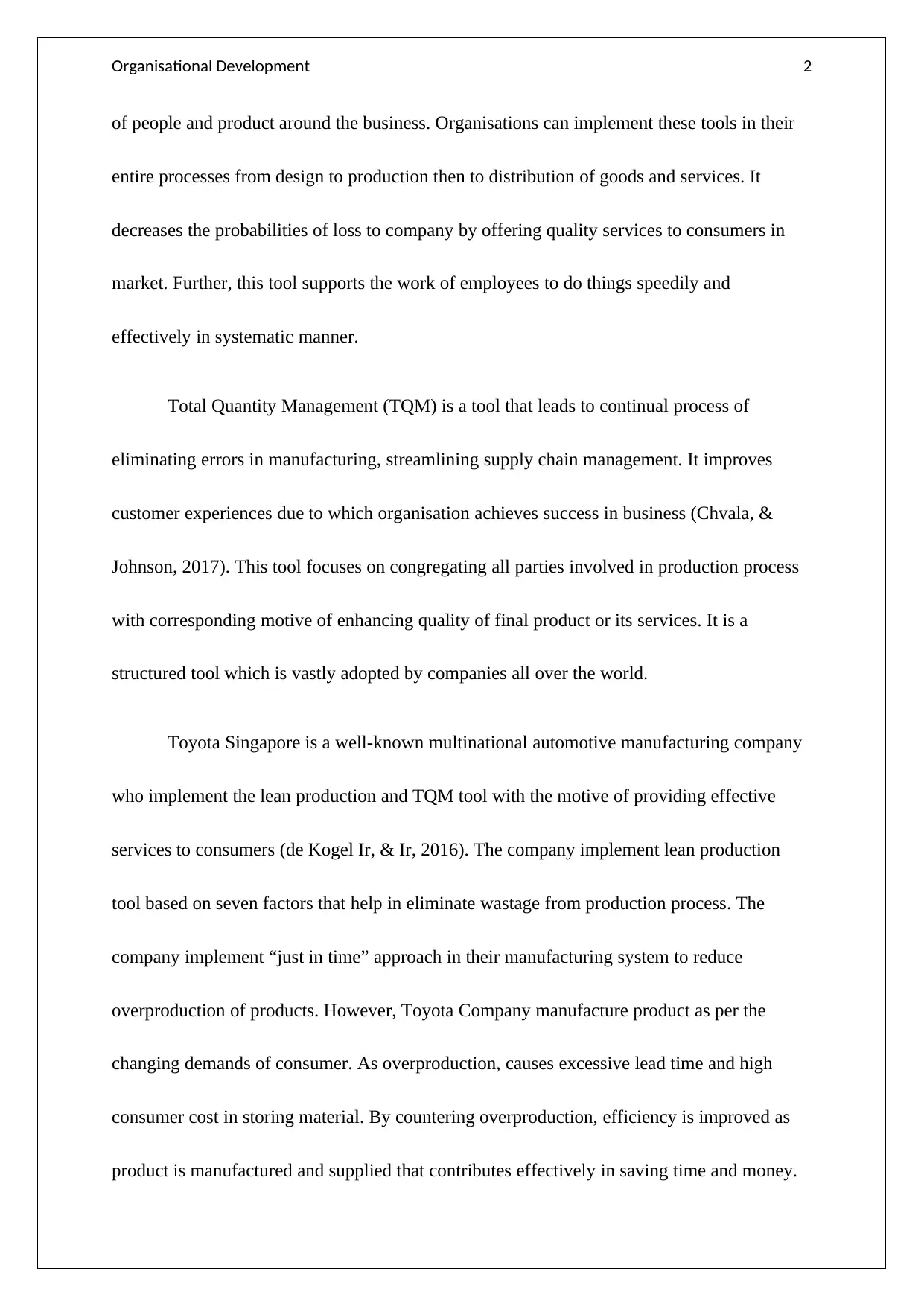
Organisational Development 2
of people and product around the business. Organisations can implement these tools in their
entire processes from design to production then to distribution of goods and services. It
decreases the probabilities of loss to company by offering quality services to consumers in
market. Further, this tool supports the work of employees to do things speedily and
effectively in systematic manner.
Total Quantity Management (TQM) is a tool that leads to continual process of
eliminating errors in manufacturing, streamlining supply chain management. It improves
customer experiences due to which organisation achieves success in business (Chvala, &
Johnson, 2017). This tool focuses on congregating all parties involved in production process
with corresponding motive of enhancing quality of final product or its services. It is a
structured tool which is vastly adopted by companies all over the world.
Toyota Singapore is a well-known multinational automotive manufacturing company
who implement the lean production and TQM tool with the motive of providing effective
services to consumers (de Kogel Ir, & Ir, 2016). The company implement lean production
tool based on seven factors that help in eliminate wastage from production process. The
company implement “just in time” approach in their manufacturing system to reduce
overproduction of products. However, Toyota Company manufacture product as per the
changing demands of consumer. As overproduction, causes excessive lead time and high
consumer cost in storing material. By countering overproduction, efficiency is improved as
product is manufactured and supplied that contributes effectively in saving time and money.
of people and product around the business. Organisations can implement these tools in their
entire processes from design to production then to distribution of goods and services. It
decreases the probabilities of loss to company by offering quality services to consumers in
market. Further, this tool supports the work of employees to do things speedily and
effectively in systematic manner.
Total Quantity Management (TQM) is a tool that leads to continual process of
eliminating errors in manufacturing, streamlining supply chain management. It improves
customer experiences due to which organisation achieves success in business (Chvala, &
Johnson, 2017). This tool focuses on congregating all parties involved in production process
with corresponding motive of enhancing quality of final product or its services. It is a
structured tool which is vastly adopted by companies all over the world.
Toyota Singapore is a well-known multinational automotive manufacturing company
who implement the lean production and TQM tool with the motive of providing effective
services to consumers (de Kogel Ir, & Ir, 2016). The company implement lean production
tool based on seven factors that help in eliminate wastage from production process. The
company implement “just in time” approach in their manufacturing system to reduce
overproduction of products. However, Toyota Company manufacture product as per the
changing demands of consumer. As overproduction, causes excessive lead time and high
consumer cost in storing material. By countering overproduction, efficiency is improved as
product is manufactured and supplied that contributes effectively in saving time and money.
⊘ This is a preview!⊘
Do you want full access?
Subscribe today to unlock all pages.

Trusted by 1+ million students worldwide
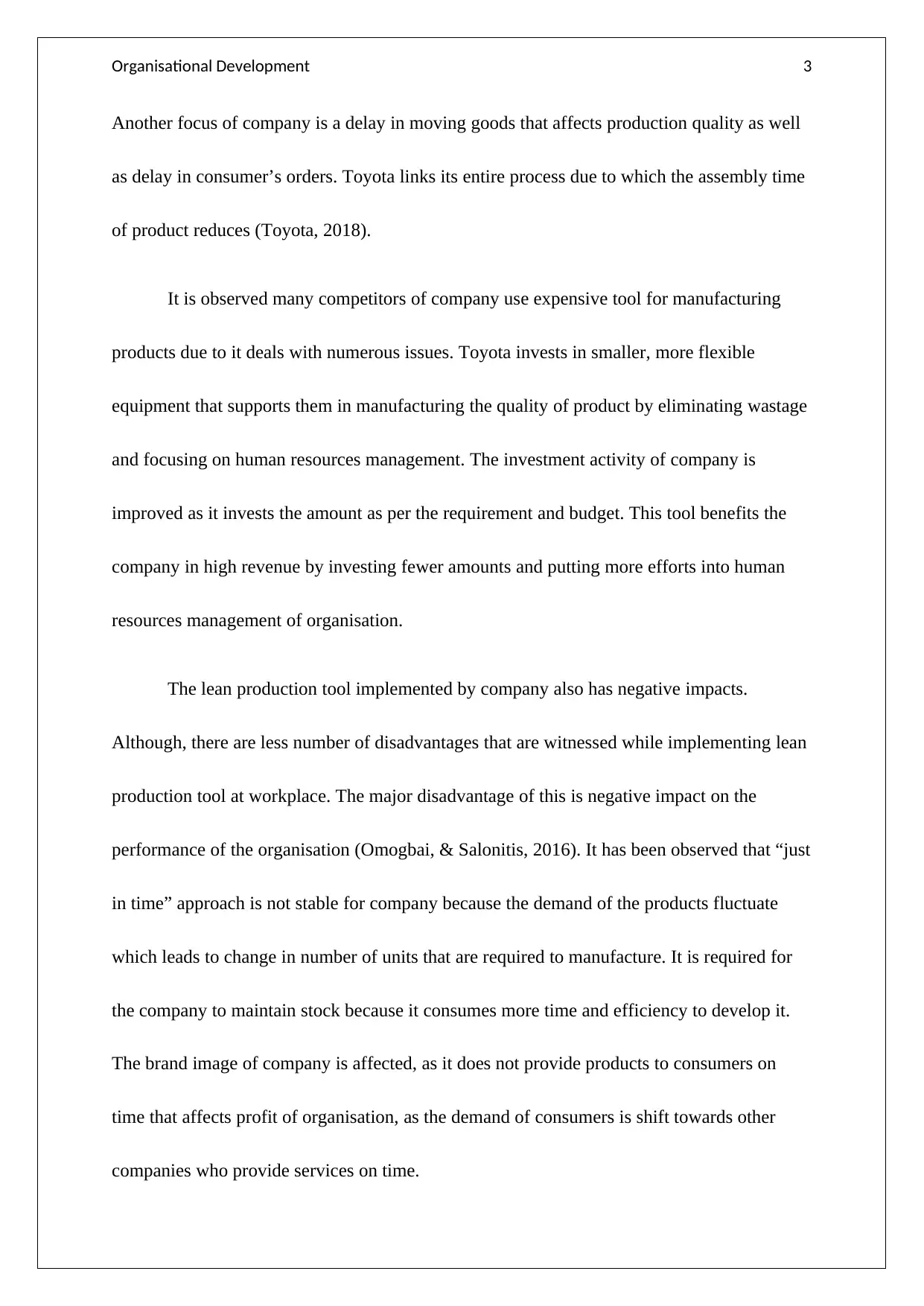
Organisational Development 3
Another focus of company is a delay in moving goods that affects production quality as well
as delay in consumer’s orders. Toyota links its entire process due to which the assembly time
of product reduces (Toyota, 2018).
It is observed many competitors of company use expensive tool for manufacturing
products due to it deals with numerous issues. Toyota invests in smaller, more flexible
equipment that supports them in manufacturing the quality of product by eliminating wastage
and focusing on human resources management. The investment activity of company is
improved as it invests the amount as per the requirement and budget. This tool benefits the
company in high revenue by investing fewer amounts and putting more efforts into human
resources management of organisation.
The lean production tool implemented by company also has negative impacts.
Although, there are less number of disadvantages that are witnessed while implementing lean
production tool at workplace. The major disadvantage of this is negative impact on the
performance of the organisation (Omogbai, & Salonitis, 2016). It has been observed that “just
in time” approach is not stable for company because the demand of the products fluctuate
which leads to change in number of units that are required to manufacture. It is required for
the company to maintain stock because it consumes more time and efficiency to develop it.
The brand image of company is affected, as it does not provide products to consumers on
time that affects profit of organisation, as the demand of consumers is shift towards other
companies who provide services on time.
Another focus of company is a delay in moving goods that affects production quality as well
as delay in consumer’s orders. Toyota links its entire process due to which the assembly time
of product reduces (Toyota, 2018).
It is observed many competitors of company use expensive tool for manufacturing
products due to it deals with numerous issues. Toyota invests in smaller, more flexible
equipment that supports them in manufacturing the quality of product by eliminating wastage
and focusing on human resources management. The investment activity of company is
improved as it invests the amount as per the requirement and budget. This tool benefits the
company in high revenue by investing fewer amounts and putting more efforts into human
resources management of organisation.
The lean production tool implemented by company also has negative impacts.
Although, there are less number of disadvantages that are witnessed while implementing lean
production tool at workplace. The major disadvantage of this is negative impact on the
performance of the organisation (Omogbai, & Salonitis, 2016). It has been observed that “just
in time” approach is not stable for company because the demand of the products fluctuate
which leads to change in number of units that are required to manufacture. It is required for
the company to maintain stock because it consumes more time and efficiency to develop it.
The brand image of company is affected, as it does not provide products to consumers on
time that affects profit of organisation, as the demand of consumers is shift towards other
companies who provide services on time.
Paraphrase This Document
Need a fresh take? Get an instant paraphrase of this document with our AI Paraphraser
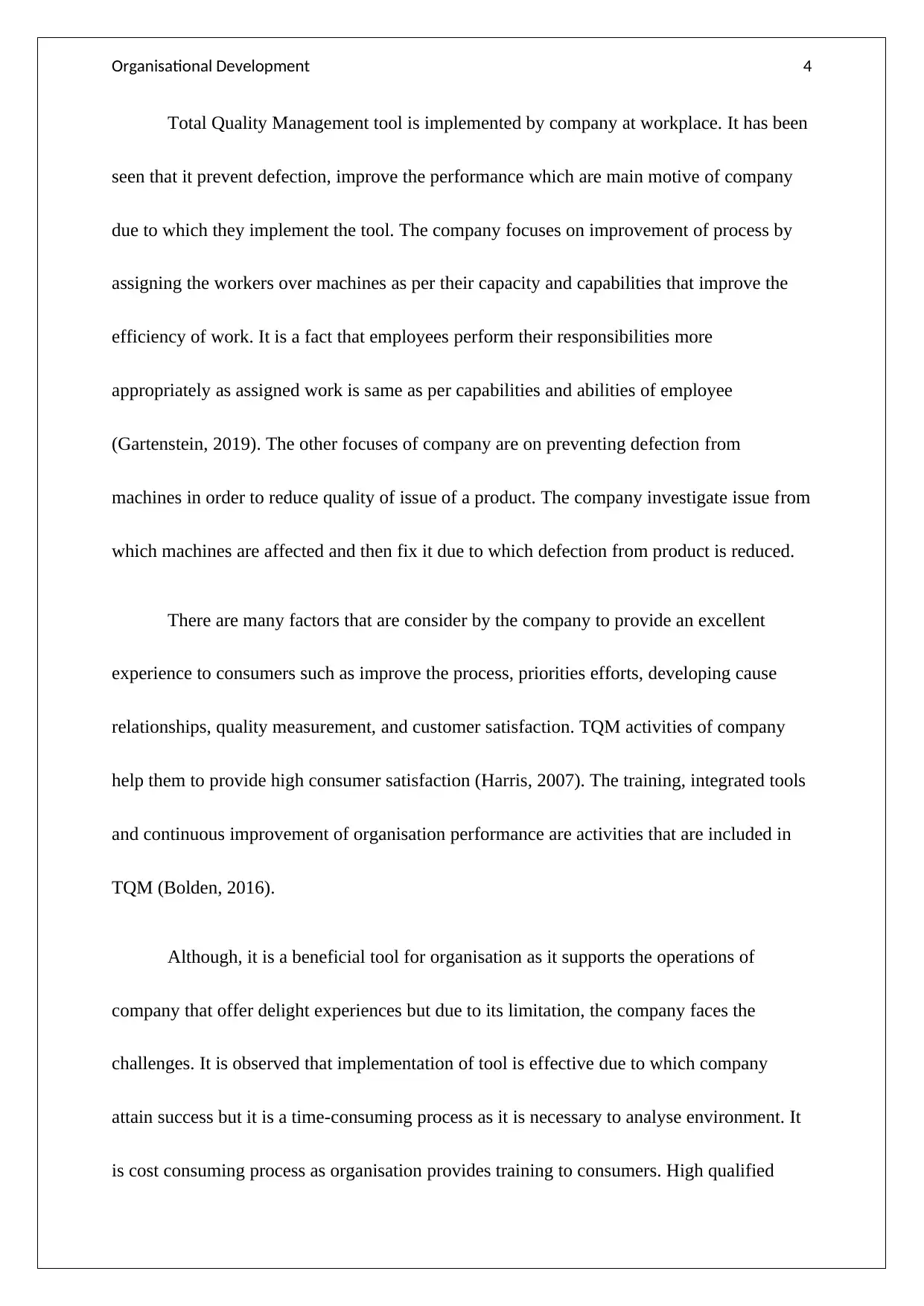
Organisational Development 4
Total Quality Management tool is implemented by company at workplace. It has been
seen that it prevent defection, improve the performance which are main motive of company
due to which they implement the tool. The company focuses on improvement of process by
assigning the workers over machines as per their capacity and capabilities that improve the
efficiency of work. It is a fact that employees perform their responsibilities more
appropriately as assigned work is same as per capabilities and abilities of employee
(Gartenstein, 2019). The other focuses of company are on preventing defection from
machines in order to reduce quality of issue of a product. The company investigate issue from
which machines are affected and then fix it due to which defection from product is reduced.
There are many factors that are consider by the company to provide an excellent
experience to consumers such as improve the process, priorities efforts, developing cause
relationships, quality measurement, and customer satisfaction. TQM activities of company
help them to provide high consumer satisfaction (Harris, 2007). The training, integrated tools
and continuous improvement of organisation performance are activities that are included in
TQM (Bolden, 2016).
Although, it is a beneficial tool for organisation as it supports the operations of
company that offer delight experiences but due to its limitation, the company faces the
challenges. It is observed that implementation of tool is effective due to which company
attain success but it is a time-consuming process as it is necessary to analyse environment. It
is cost consuming process as organisation provides training to consumers. High qualified
Total Quality Management tool is implemented by company at workplace. It has been
seen that it prevent defection, improve the performance which are main motive of company
due to which they implement the tool. The company focuses on improvement of process by
assigning the workers over machines as per their capacity and capabilities that improve the
efficiency of work. It is a fact that employees perform their responsibilities more
appropriately as assigned work is same as per capabilities and abilities of employee
(Gartenstein, 2019). The other focuses of company are on preventing defection from
machines in order to reduce quality of issue of a product. The company investigate issue from
which machines are affected and then fix it due to which defection from product is reduced.
There are many factors that are consider by the company to provide an excellent
experience to consumers such as improve the process, priorities efforts, developing cause
relationships, quality measurement, and customer satisfaction. TQM activities of company
help them to provide high consumer satisfaction (Harris, 2007). The training, integrated tools
and continuous improvement of organisation performance are activities that are included in
TQM (Bolden, 2016).
Although, it is a beneficial tool for organisation as it supports the operations of
company that offer delight experiences but due to its limitation, the company faces the
challenges. It is observed that implementation of tool is effective due to which company
attain success but it is a time-consuming process as it is necessary to analyse environment. It
is cost consuming process as organisation provides training to consumers. High qualified
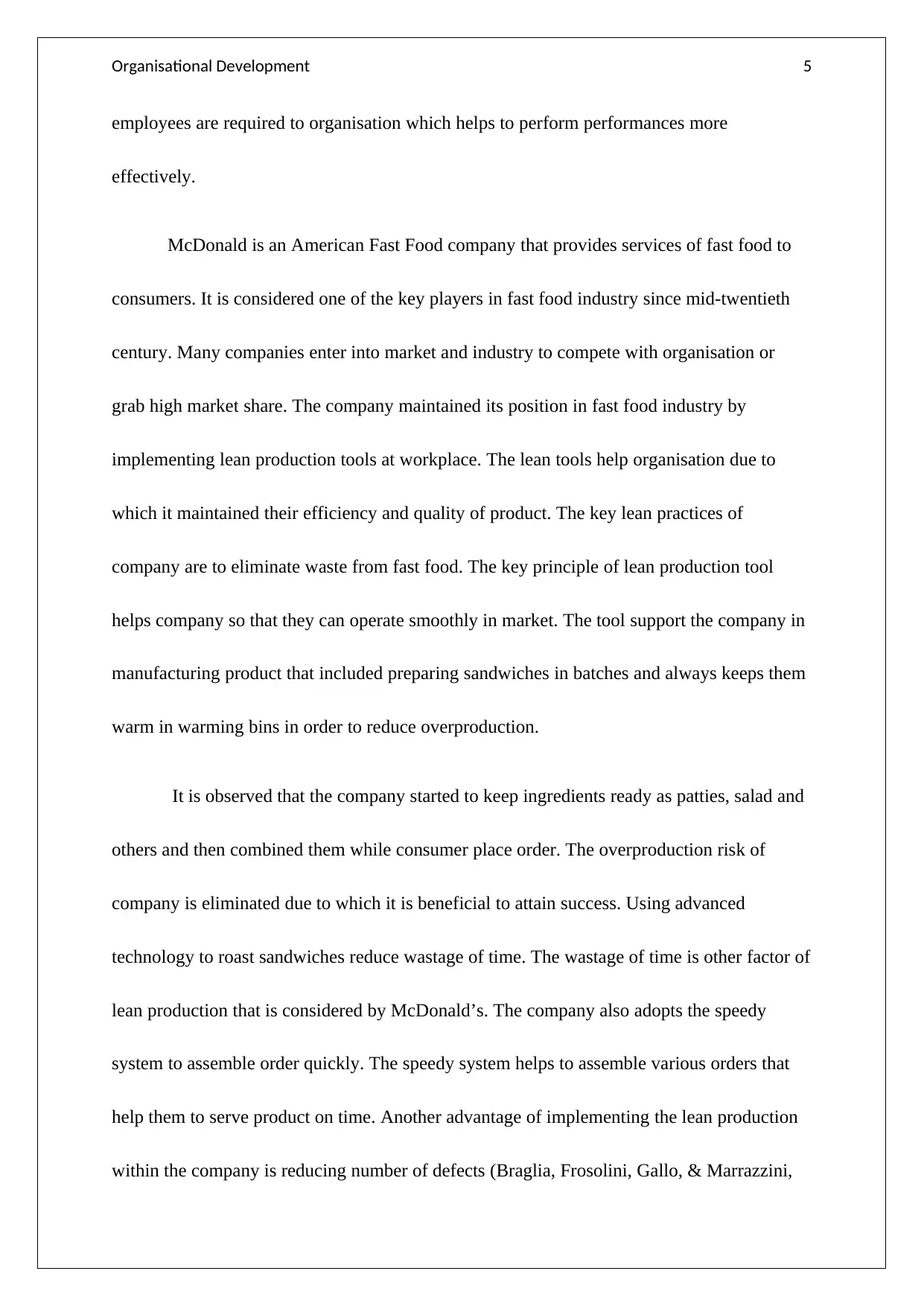
Organisational Development 5
employees are required to organisation which helps to perform performances more
effectively.
McDonald is an American Fast Food company that provides services of fast food to
consumers. It is considered one of the key players in fast food industry since mid-twentieth
century. Many companies enter into market and industry to compete with organisation or
grab high market share. The company maintained its position in fast food industry by
implementing lean production tools at workplace. The lean tools help organisation due to
which it maintained their efficiency and quality of product. The key lean practices of
company are to eliminate waste from fast food. The key principle of lean production tool
helps company so that they can operate smoothly in market. The tool support the company in
manufacturing product that included preparing sandwiches in batches and always keeps them
warm in warming bins in order to reduce overproduction.
It is observed that the company started to keep ingredients ready as patties, salad and
others and then combined them while consumer place order. The overproduction risk of
company is eliminated due to which it is beneficial to attain success. Using advanced
technology to roast sandwiches reduce wastage of time. The wastage of time is other factor of
lean production that is considered by McDonald’s. The company also adopts the speedy
system to assemble order quickly. The speedy system helps to assemble various orders that
help them to serve product on time. Another advantage of implementing the lean production
within the company is reducing number of defects (Braglia, Frosolini, Gallo, & Marrazzini,
employees are required to organisation which helps to perform performances more
effectively.
McDonald is an American Fast Food company that provides services of fast food to
consumers. It is considered one of the key players in fast food industry since mid-twentieth
century. Many companies enter into market and industry to compete with organisation or
grab high market share. The company maintained its position in fast food industry by
implementing lean production tools at workplace. The lean tools help organisation due to
which it maintained their efficiency and quality of product. The key lean practices of
company are to eliminate waste from fast food. The key principle of lean production tool
helps company so that they can operate smoothly in market. The tool support the company in
manufacturing product that included preparing sandwiches in batches and always keeps them
warm in warming bins in order to reduce overproduction.
It is observed that the company started to keep ingredients ready as patties, salad and
others and then combined them while consumer place order. The overproduction risk of
company is eliminated due to which it is beneficial to attain success. Using advanced
technology to roast sandwiches reduce wastage of time. The wastage of time is other factor of
lean production that is considered by McDonald’s. The company also adopts the speedy
system to assemble order quickly. The speedy system helps to assemble various orders that
help them to serve product on time. Another advantage of implementing the lean production
within the company is reducing number of defects (Braglia, Frosolini, Gallo, & Marrazzini,
⊘ This is a preview!⊘
Do you want full access?
Subscribe today to unlock all pages.

Trusted by 1+ million students worldwide
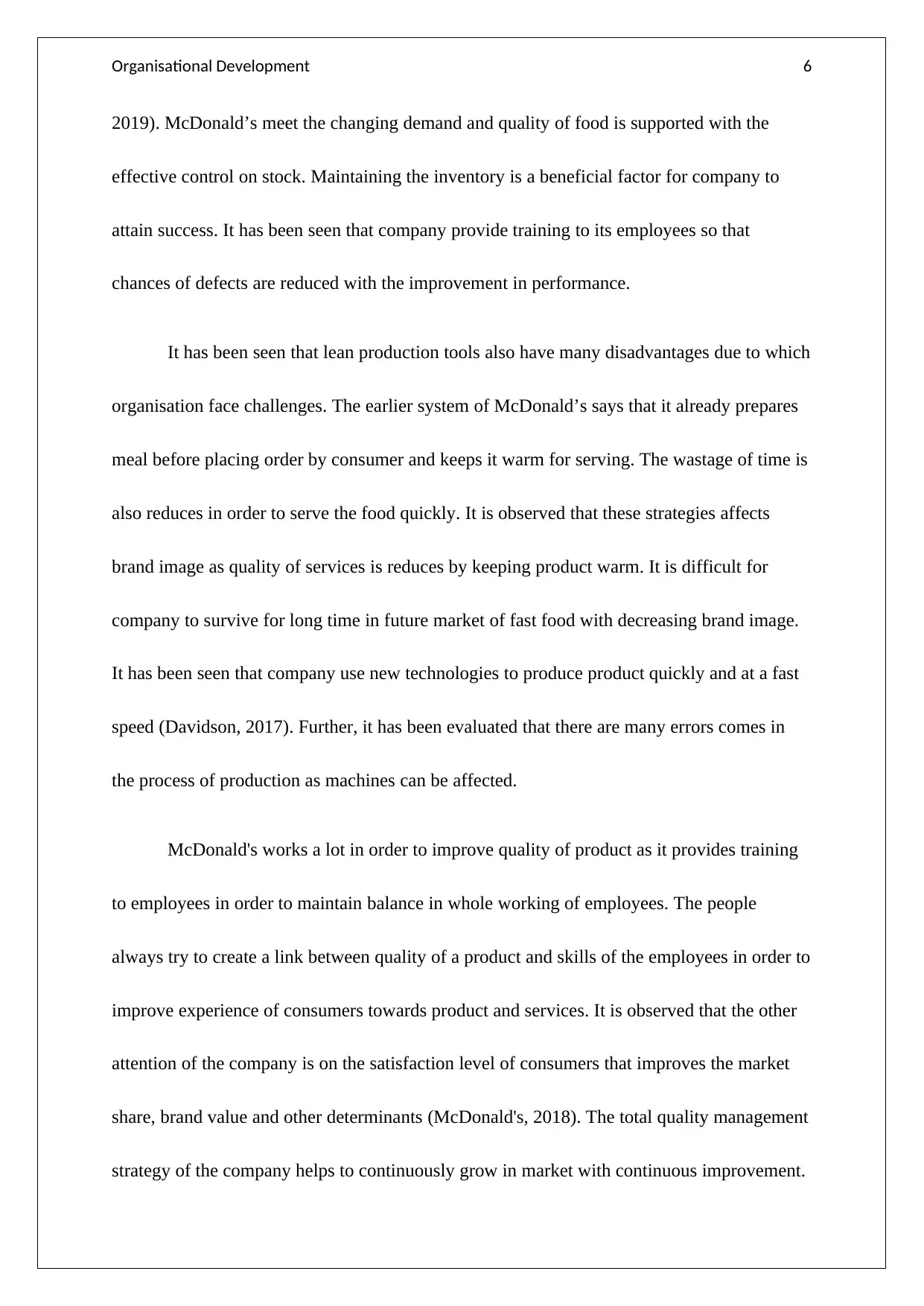
Organisational Development 6
2019). McDonald’s meet the changing demand and quality of food is supported with the
effective control on stock. Maintaining the inventory is a beneficial factor for company to
attain success. It has been seen that company provide training to its employees so that
chances of defects are reduced with the improvement in performance.
It has been seen that lean production tools also have many disadvantages due to which
organisation face challenges. The earlier system of McDonald’s says that it already prepares
meal before placing order by consumer and keeps it warm for serving. The wastage of time is
also reduces in order to serve the food quickly. It is observed that these strategies affects
brand image as quality of services is reduces by keeping product warm. It is difficult for
company to survive for long time in future market of fast food with decreasing brand image.
It has been seen that company use new technologies to produce product quickly and at a fast
speed (Davidson, 2017). Further, it has been evaluated that there are many errors comes in
the process of production as machines can be affected.
McDonald's works a lot in order to improve quality of product as it provides training
to employees in order to maintain balance in whole working of employees. The people
always try to create a link between quality of a product and skills of the employees in order to
improve experience of consumers towards product and services. It is observed that the other
attention of the company is on the satisfaction level of consumers that improves the market
share, brand value and other determinants (McDonald's, 2018). The total quality management
strategy of the company helps to continuously grow in market with continuous improvement.
2019). McDonald’s meet the changing demand and quality of food is supported with the
effective control on stock. Maintaining the inventory is a beneficial factor for company to
attain success. It has been seen that company provide training to its employees so that
chances of defects are reduced with the improvement in performance.
It has been seen that lean production tools also have many disadvantages due to which
organisation face challenges. The earlier system of McDonald’s says that it already prepares
meal before placing order by consumer and keeps it warm for serving. The wastage of time is
also reduces in order to serve the food quickly. It is observed that these strategies affects
brand image as quality of services is reduces by keeping product warm. It is difficult for
company to survive for long time in future market of fast food with decreasing brand image.
It has been seen that company use new technologies to produce product quickly and at a fast
speed (Davidson, 2017). Further, it has been evaluated that there are many errors comes in
the process of production as machines can be affected.
McDonald's works a lot in order to improve quality of product as it provides training
to employees in order to maintain balance in whole working of employees. The people
always try to create a link between quality of a product and skills of the employees in order to
improve experience of consumers towards product and services. It is observed that the other
attention of the company is on the satisfaction level of consumers that improves the market
share, brand value and other determinants (McDonald's, 2018). The total quality management
strategy of the company helps to continuously grow in market with continuous improvement.
Paraphrase This Document
Need a fresh take? Get an instant paraphrase of this document with our AI Paraphraser
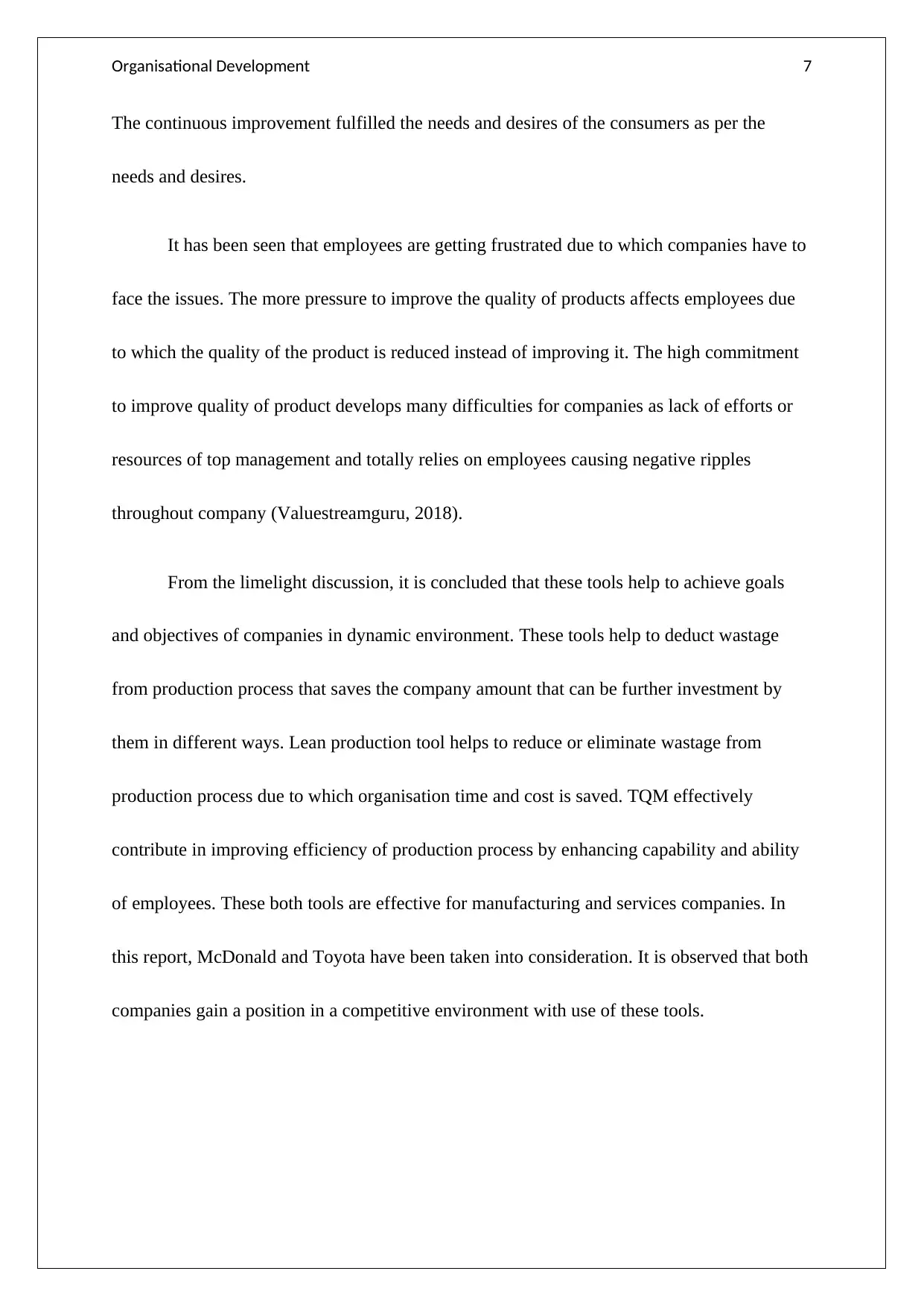
Organisational Development 7
The continuous improvement fulfilled the needs and desires of the consumers as per the
needs and desires.
It has been seen that employees are getting frustrated due to which companies have to
face the issues. The more pressure to improve the quality of products affects employees due
to which the quality of the product is reduced instead of improving it. The high commitment
to improve quality of product develops many difficulties for companies as lack of efforts or
resources of top management and totally relies on employees causing negative ripples
throughout company (Valuestreamguru, 2018).
From the limelight discussion, it is concluded that these tools help to achieve goals
and objectives of companies in dynamic environment. These tools help to deduct wastage
from production process that saves the company amount that can be further investment by
them in different ways. Lean production tool helps to reduce or eliminate wastage from
production process due to which organisation time and cost is saved. TQM effectively
contribute in improving efficiency of production process by enhancing capability and ability
of employees. These both tools are effective for manufacturing and services companies. In
this report, McDonald and Toyota have been taken into consideration. It is observed that both
companies gain a position in a competitive environment with use of these tools.
The continuous improvement fulfilled the needs and desires of the consumers as per the
needs and desires.
It has been seen that employees are getting frustrated due to which companies have to
face the issues. The more pressure to improve the quality of products affects employees due
to which the quality of the product is reduced instead of improving it. The high commitment
to improve quality of product develops many difficulties for companies as lack of efforts or
resources of top management and totally relies on employees causing negative ripples
throughout company (Valuestreamguru, 2018).
From the limelight discussion, it is concluded that these tools help to achieve goals
and objectives of companies in dynamic environment. These tools help to deduct wastage
from production process that saves the company amount that can be further investment by
them in different ways. Lean production tool helps to reduce or eliminate wastage from
production process due to which organisation time and cost is saved. TQM effectively
contribute in improving efficiency of production process by enhancing capability and ability
of employees. These both tools are effective for manufacturing and services companies. In
this report, McDonald and Toyota have been taken into consideration. It is observed that both
companies gain a position in a competitive environment with use of these tools.
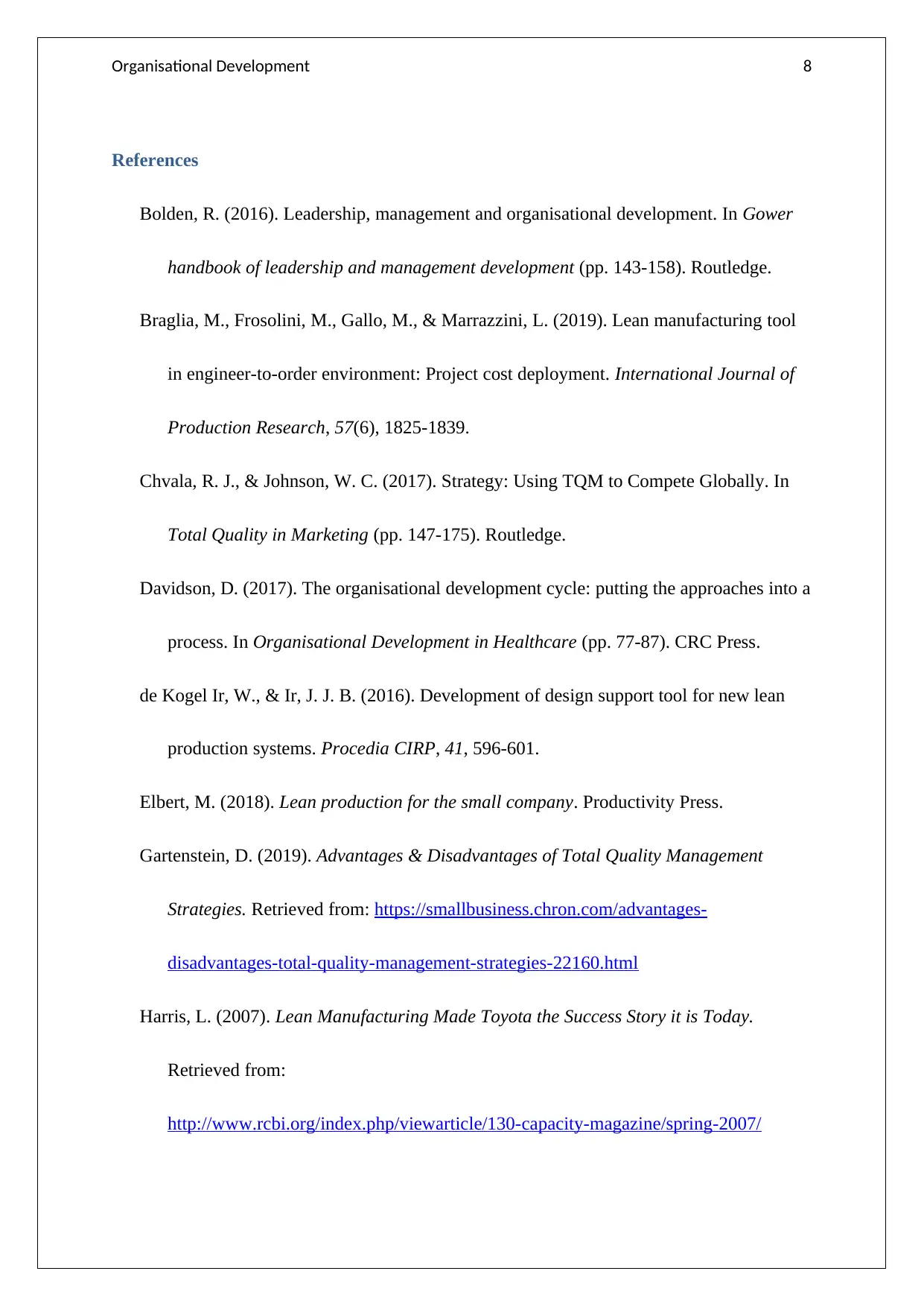
Organisational Development 8
References
Bolden, R. (2016). Leadership, management and organisational development. In Gower
handbook of leadership and management development (pp. 143-158). Routledge.
Braglia, M., Frosolini, M., Gallo, M., & Marrazzini, L. (2019). Lean manufacturing tool
in engineer-to-order environment: Project cost deployment. International Journal of
Production Research, 57(6), 1825-1839.
Chvala, R. J., & Johnson, W. C. (2017). Strategy: Using TQM to Compete Globally. In
Total Quality in Marketing (pp. 147-175). Routledge.
Davidson, D. (2017). The organisational development cycle: putting the approaches into a
process. In Organisational Development in Healthcare (pp. 77-87). CRC Press.
de Kogel Ir, W., & Ir, J. J. B. (2016). Development of design support tool for new lean
production systems. Procedia CIRP, 41, 596-601.
Elbert, M. (2018). Lean production for the small company. Productivity Press.
Gartenstein, D. (2019). Advantages & Disadvantages of Total Quality Management
Strategies. Retrieved from: https://smallbusiness.chron.com/advantages-
disadvantages-total-quality-management-strategies-22160.html
Harris, L. (2007). Lean Manufacturing Made Toyota the Success Story it is Today.
Retrieved from:
http://www.rcbi.org/index.php/viewarticle/130-capacity-magazine/spring-2007/
References
Bolden, R. (2016). Leadership, management and organisational development. In Gower
handbook of leadership and management development (pp. 143-158). Routledge.
Braglia, M., Frosolini, M., Gallo, M., & Marrazzini, L. (2019). Lean manufacturing tool
in engineer-to-order environment: Project cost deployment. International Journal of
Production Research, 57(6), 1825-1839.
Chvala, R. J., & Johnson, W. C. (2017). Strategy: Using TQM to Compete Globally. In
Total Quality in Marketing (pp. 147-175). Routledge.
Davidson, D. (2017). The organisational development cycle: putting the approaches into a
process. In Organisational Development in Healthcare (pp. 77-87). CRC Press.
de Kogel Ir, W., & Ir, J. J. B. (2016). Development of design support tool for new lean
production systems. Procedia CIRP, 41, 596-601.
Elbert, M. (2018). Lean production for the small company. Productivity Press.
Gartenstein, D. (2019). Advantages & Disadvantages of Total Quality Management
Strategies. Retrieved from: https://smallbusiness.chron.com/advantages-
disadvantages-total-quality-management-strategies-22160.html
Harris, L. (2007). Lean Manufacturing Made Toyota the Success Story it is Today.
Retrieved from:
http://www.rcbi.org/index.php/viewarticle/130-capacity-magazine/spring-2007/
⊘ This is a preview!⊘
Do you want full access?
Subscribe today to unlock all pages.

Trusted by 1+ million students worldwide
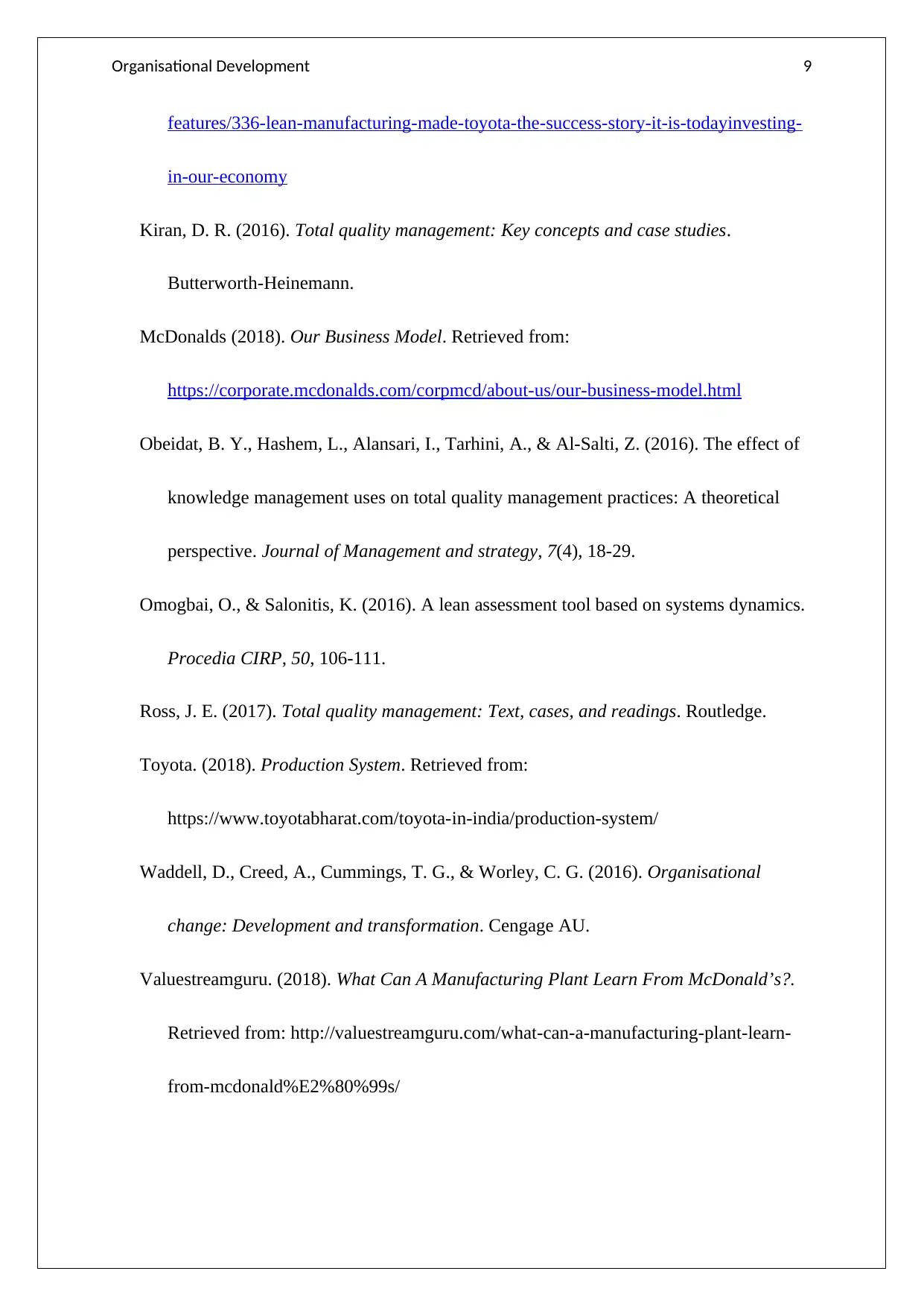
Organisational Development 9
features/336-lean-manufacturing-made-toyota-the-success-story-it-is-todayinvesting-
in-our-economy
Kiran, D. R. (2016). Total quality management: Key concepts and case studies.
Butterworth-Heinemann.
McDonalds (2018). Our Business Model. Retrieved from:
https://corporate.mcdonalds.com/corpmcd/about-us/our-business-model.html
Obeidat, B. Y., Hashem, L., Alansari, I., Tarhini, A., & Al-Salti, Z. (2016). The effect of
knowledge management uses on total quality management practices: A theoretical
perspective. Journal of Management and strategy, 7(4), 18-29.
Omogbai, O., & Salonitis, K. (2016). A lean assessment tool based on systems dynamics.
Procedia CIRP, 50, 106-111.
Ross, J. E. (2017). Total quality management: Text, cases, and readings. Routledge.
Toyota. (2018). Production System. Retrieved from:
https://www.toyotabharat.com/toyota-in-india/production-system/
Waddell, D., Creed, A., Cummings, T. G., & Worley, C. G. (2016). Organisational
change: Development and transformation. Cengage AU.
Valuestreamguru. (2018). What Can A Manufacturing Plant Learn From McDonald’s?.
Retrieved from: http://valuestreamguru.com/what-can-a-manufacturing-plant-learn-
from-mcdonald%E2%80%99s/
features/336-lean-manufacturing-made-toyota-the-success-story-it-is-todayinvesting-
in-our-economy
Kiran, D. R. (2016). Total quality management: Key concepts and case studies.
Butterworth-Heinemann.
McDonalds (2018). Our Business Model. Retrieved from:
https://corporate.mcdonalds.com/corpmcd/about-us/our-business-model.html
Obeidat, B. Y., Hashem, L., Alansari, I., Tarhini, A., & Al-Salti, Z. (2016). The effect of
knowledge management uses on total quality management practices: A theoretical
perspective. Journal of Management and strategy, 7(4), 18-29.
Omogbai, O., & Salonitis, K. (2016). A lean assessment tool based on systems dynamics.
Procedia CIRP, 50, 106-111.
Ross, J. E. (2017). Total quality management: Text, cases, and readings. Routledge.
Toyota. (2018). Production System. Retrieved from:
https://www.toyotabharat.com/toyota-in-india/production-system/
Waddell, D., Creed, A., Cummings, T. G., & Worley, C. G. (2016). Organisational
change: Development and transformation. Cengage AU.
Valuestreamguru. (2018). What Can A Manufacturing Plant Learn From McDonald’s?.
Retrieved from: http://valuestreamguru.com/what-can-a-manufacturing-plant-learn-
from-mcdonald%E2%80%99s/
Paraphrase This Document
Need a fresh take? Get an instant paraphrase of this document with our AI Paraphraser
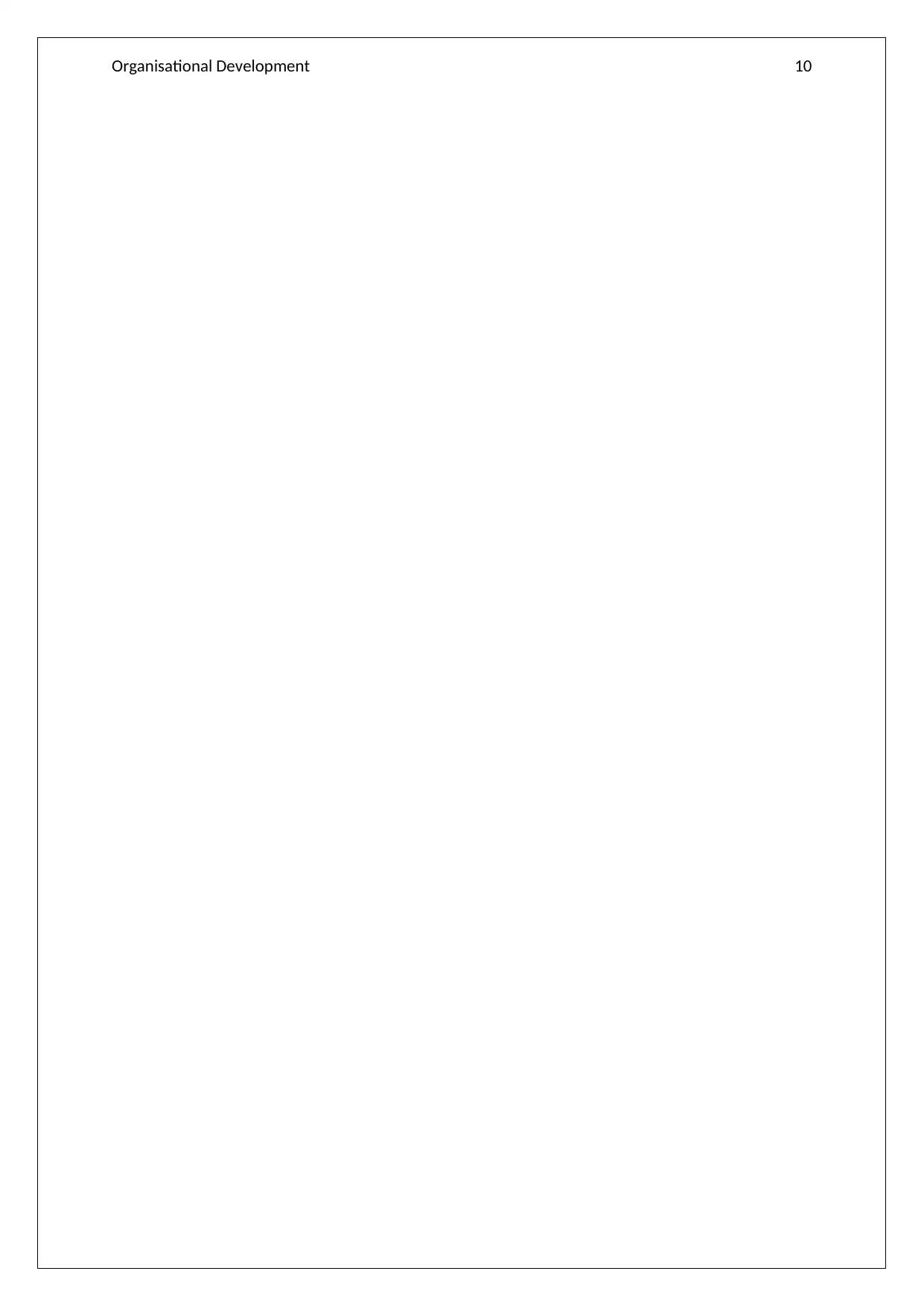
Organisational Development 10
1 out of 11
Related Documents
Your All-in-One AI-Powered Toolkit for Academic Success.
+13062052269
info@desklib.com
Available 24*7 on WhatsApp / Email
![[object Object]](/_next/static/media/star-bottom.7253800d.svg)
Unlock your academic potential
Copyright © 2020–2025 A2Z Services. All Rights Reserved. Developed and managed by ZUCOL.




